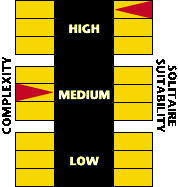Cross Bronx Expressway
Available for Pre-Order. In Art and Final Development

Prototype Game Board

A derelict building in the Bronx

Beginning in the 1940s, New York embarked upon infrastructure and urban renewal projects that would reshape the city, including the culturally rich working class neighborhoods of the South Bronx. The game takes its name from one particularly infamous infrastructure project, an expressway conceived of and championed by the city's "construction coordinator" Robert Moses, which from 1948 to 1972 gradually cut through the borough, disrupting neighborhoods and businesses alike. This, and other similar infrastructure projects, impacted the local fabric of existing communities in ways that are still having an effect to this day.

Prototype event cards
The South Bronx also underwent significant demographic, economic, and social changes during this period. The existing European immigrant population, which had watched World War II unfold from the Bronx, went on to use post-war financial incentives to leave for the suburbs. With the introduction of commercial air travel, a new wave of migrants arrived from Puerto Rico, while segregation in the South saw many African Americans moving to the area. This growing minority population led to redlining policies which restricted real estate investment. At the same time, roadway and infrastructure projects used eminent domain laws to seize property and move forward with large-scale redevelopment, often at the cost of those already living locally. Neglected housing and social services reached a boiling point in 1977, when a citywide blackout combined with looting and arson to devastate the Bronx.

Prototype Event Cards

Prototype Event Cards
Components:
-
22x34" mounted game board
-
Event Deck
-
Card-Driven Solo-System Deck
-
152 Wooden Pieces
-
One half-size, full-color counter sheet
-
Three fold-out player aid sheets
-
One fold-out solo play aid
-
One custom 6-sided die
-
One standard 6-sided die
-
1 Rule Book
-
1 Playbook

Game Developer: Joe Dewhurst

